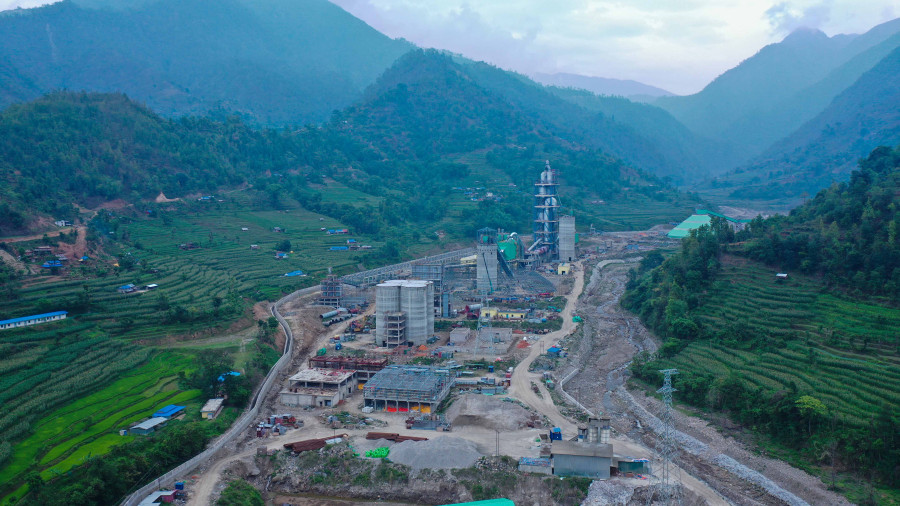Money
Nepal will require 26 million tonnes of cement annually by 2024-25, report says
Foreign direct investment in the cement industry stands at Rs56.97 billion, according to Nepal Rastra Bank.
Krishana Prasain
Nepal is estimated to require 25.88 million tonnes of cement annually by 2024-25 due to an investment push in mega infrastructure projects, a study on the socio-economic impact of foreign direct investment in the country's cement industry published by Nepal Rastra Bank on Friday showed.
There are several big, medium and small projects, including a large number of national pride projects under construction, which are the major drivers for cement demand, the report said.
In 2019, the Ministry of Industry, Commerce and Supplies had projected that the installed capacity of Nepal's cement industry could increase to 20 million tonnes by the end of 2023-24, from 15 million tonnes currently.
According to the report, the actual annual production, before the Covid-19 pandemic, hovers around 7.5 million tonnes although the installed capacity is 15 million tonnes.
Domestic consumption amounts to 9.05 million tonnes, and the shortfall is covered by imports. In 2018-19, according to the report, 1.56 million tonnes of cement was imported from India.
The report said that most of the mega projects in Nepal use cements imported from India due to issues of certification, quality consistency and inability to provide bulk supply.
The survey was conducted in seven cement factories—three run by foreign investors, two state-owned and two private sector-run factories—out of the 55 plants currently in operation in the country.
Foreign direct investment in the cement industry in Nepal stands at Rs56.97 billion. Two new foreign-funded factories are under construction, according to the survey report. These three foreign investment cement factories constitute 20.31 percent of the total installed capacity of the cement industry.
Nepali investors have injected Rs122.33 billion in the cement industry.
According to the report, the average daily production of the three foreign investment factories is 2,783 tonnes while the two state-owned factories churn out 820 tonnes of cement daily. The 50 private factories collectively produce 622 tonnes daily.
The foreign investment-based cement factories are found to be more efficient and profitable than the government-owned or private cement factories, the survey revealed.
In order to produce 1 tonne of cement, the foreign investment-based factory uses 0.99 tonne of limestone on average. In contrast, the state-owned factory uses 1.45 tonnes.
Similarly, the production cost to sales ratio of the foreign-funded factory is about 46.63 percent, compared to 48.95 percent and 82.18 percent of private and state-owned factories respectively.
This is because of the superior technology used by the foreign-funded factories, the report said. But the Nepali private sector says the survey report is misleading.
Dhruba Raj Thapa, president of the Cement Manufacturers Association of Nepal, said the data provided in the report is not authentic and is misleading.
According to him, there are 64 cement factories operating in Nepal, and not 55 as mentioned in the report.
“The report shows that the cement production capacity is 15 million tonnes annually, but the capacity is actually 22 million tonnes,” he said.
He admits that the cement produced by the Nepali private sector is sold at a relatively lower price.
The central bank’s survey report said that Nepal was on track to become self-reliant in cement production. But Thapa rejects the statement saying that Nepal became self-reliant in cement production four years ago.
Thapa also refuted the claim that Nepali cement was not good enough for mega projects.
According to him, the industry started classifying Nepali cement as 43 grade or 53 grade from last year. “Grading ensures the quality of the product.”
Thapa said 70 percent of the country's cement factories were operating at around 40 percent of capacity due to the Covid-19 pandemic while the rest had shut down.
Demand for cement in the market has plunged by more than 50 percent as most of the construction projects have shut down.
As per Trade and Export Promotion Centre figures, the country imported clinker, a major ingredient used to manufacture cement worth Rs3.37 billion in the first nine months of the current fiscal year, up 41 percent year-on-year.
The report has suggested that the government should create policy, including provision of certification of cement, to encourage production and export.
As the cement industry is one of the most pollution emitting industries, the report recommended that it should be mandated to invest in local development such as the construction of roads, schools and hospitals as part of its corporate social responsibility.
Stating that foreign direct investment helps to bring new technology into the country and promote competition, making the domestic industry more efficient, the report has recommended allowing foreign direct investment only on the condition that local investors hold a certain minimum percentage of the equity in such new entrant companies.




 7.12°C Kathmandu
7.12°C Kathmandu














